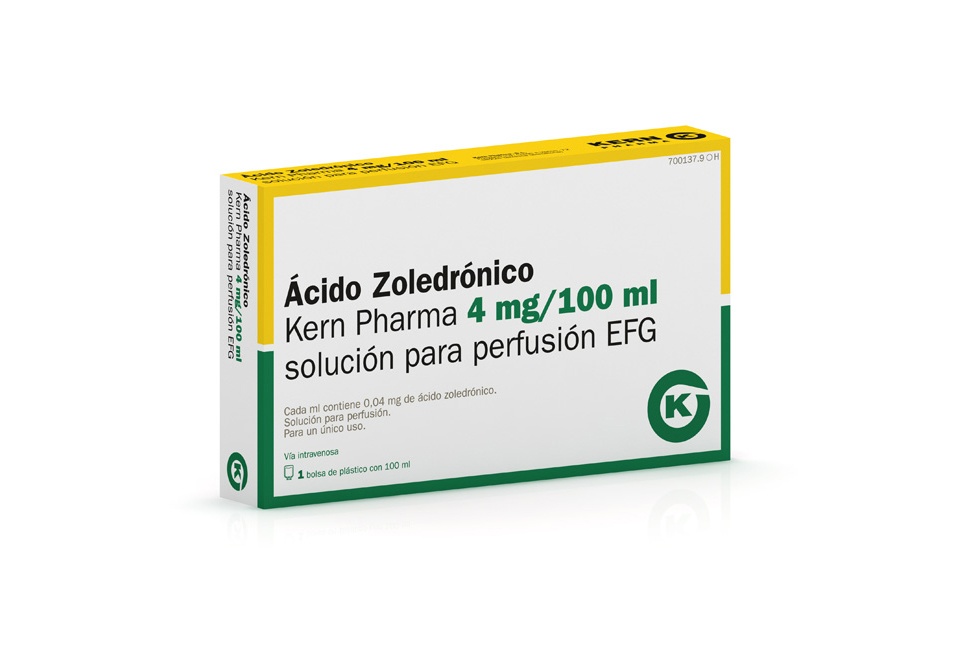

Ácido Zoledrónico Altan 4 mg/100 ml Solução para Perfusão

Pergunte a um médico sobre a prescrição de Ácido Zoledrónico Altan 4 mg/100 ml Solução para Perfusão

Como usar Ácido Zoledrónico Altan 4 mg/100 ml Solução para Perfusão
Introdução
Prospecto: informação para o paciente
Ácido Zoledrônico Altan 4 mg/100 ml solução para perfusão EFG
Leia todo o prospecto atentamente antes de receber este medicamento, porque contém informações importantes para si.
- Conserva este prospecto, porque pode ter que relê-lo.
- Se tiver alguma dúvida, consulte o seu médico, farmacêutico ou enfermeiro.
- Se experimentar efeitos adversos, consulte o seu médico, farmacêutico ou enfermeiro, mesmo que se trate de efeitos adversos que não aparecem neste prospecto. Ver seção 4.
Conteúdo do prospecto
- O que é Ácido Zoledrônico Altan e para que é utilizado
- O que precisa saber antes de começar a usar Ácido Zoledrônico Altan
- Como usar Ácido Zoledrônico Altan
- Possíveis efeitos adversos
- Conservação de Ácido Zoledrônico Altan
- Conteúdo do envase e informação adicional
1. O que é Ácido Zoledrônico Altan e para que é utilizado
O princípio ativo deste medicamento é o ácido zoledrônico, que pertence a um grupo de substâncias chamadas bisfosfonatos. O ácido zoledrônico actua unindo-se aos ossos e reduzindo a velocidade do remodelamento ósseo. É utilizado para:
- Prevenir as complicações ósseas, p. ex., fracturas, em pacientes adultos com metástases ósseas (disseminação do cancro desde o local primário até ao osso)
Reduzir a quantidade de cálciono sangue em pacientes adultos em que é demasiado alto devido à presença de um tumor. Os tumores podem acelerar o remodelamento ósseo normal de maneira que a libertação de cálcio desde o osso esteja aumentada. Esta condição é conhecida como hipercalcemia induzida por tumor (HIT).
2. O que precisa saber antes de começar a usar Ácido Zoledrônico Altan
Siga cuidadosamente todas as instruções que o seu médico lhe der.
O seu médico fará análises de sangue antes de começar o tratamento com Ácido Zoledrônico Altan e controlará a sua resposta ao tratamento a intervalos regulares.
Não lhe deve ser administrado Ácido Zoledrônico Altan:
- se estiver em período de amamentação.
- se for alérgico ao ácido zoledrônico, outro bisfosfonato (grupo de substâncias a que pertence Ácido Zoledrônico Altan), ou a qualquer um dos outros componentes deste medicamento (incluídos na seção 6).
Advertências e precauções
Consulte o seu médicoou farmacêuticoantes decomeçar a usarÁcido Zoledrônico Altan:
- se tiver ou tiver tido um problema de rim.
- se tiver ou tiver tido dor, inchaço ou adormecimentoda mandíbula, ou uma sensação de pesadez na mandíbula ou se lhe mover um dente. O seu médico pode recomendar que se submeta a um exame dental antes de iniciar o tratamento com ácido zoledrônico.
- se estiver a receber tratamento dentalou vai se submeter a cirurgia dental, informe o seu dentista de que está a ser tratado com ácido zoledrônico e informe o seu médico sobre o seu tratamento dental.
Enquanto estiver a ser tratado com este medicamento, deve manter uma boa higiene bucal (incluindo escovação regular dos dentes) e se submeter a check-ups dentais rotineiros.
Entre em contato com o seu médico e dentista imediatamente se experimentar qualquer problema com a boca ou dentes, tais como perda dental, dor ou inchaço, ou dificuldade na cura de úlceras ou secreção, pois estes podem ser sinais de uma situação denominada osteonecrose da mandíbula.
Os pacientes que estão a receber quimioterapia e/ou radioterapia, que estão a tomar corticosteroides, que estão a se submeter a cirurgia dental, que não recebem um cuidado dental rotineiro, que têm doença nas gengivas, que são fumadores ou que não receberam um tratamento prévio com um bisfosfonato (utilizado para tratar ou prevenir alterações nos ossos) podem apresentar um maior risco de desenvolver osteonecrose da mandíbula.
Foram descritos níveis reduzidos de cálcio no sangue (hipocalcemia), que às vezes se manifestam com cãibras musculares, pele seca e sensação de queimadura em pacientes que receberam ácido zoledrônico. Foi descrito ritmo irregular do coração (arritmia cardíaca), convulsões, espasmos e contrações musculares involuntárias (tetania) secundários à hipocalcemia grave. Em alguns casos, a hipocalcemia pode resultar potencialmente mortal. Se tiver alguma das condições descritas, informe o seu médico imediatamente. Se sofrer uma hipocalcemia prévia, esta deve ser corrigida antes de receber a primeira dose de ácido zoledrônico. Ser-lhe-ão fornecidos suplementos adequados de cálcio e vitamina D.
Pacientes de 65 anos e mais velhos
Ácido zoledrônico pode ser administrado a pessoas de 65 anos e mais velhos. Não existem evidências que sugiram que são necessárias precauções adicionais.
Crianças e adolescentes
Não se recomenda o uso de ácido zoledrônico em adolescentes e crianças menores de 18 anos.
Outros medicamentos e Ácido Zoledrônico Altan
Informa o seu médico se está a utilizar, utilizou recentemente ou pode ter que utilizar qualquer outro medicamento. É especialmente importante que informe o seu médico se também está a tomar:
- Aminoglicosídeos (medicamentos utilizados para o tratamento de infecções graves), calcitonina (um tipo de medicamento utilizado para o tratamento da osteoporose pós-menopáusica e da hipercalcemia), diuréticos de alça (um tipo de medicamento para o tratamento da tensão arterial alta ou edema) ou outros medicamentos que diminuem o cálcio, dado que a combinação destes com bisfosfonatos pode diminuir acentuadamente a concentração de cálcio no sangue.
- Talidomida (um medicamento utilizado para tratar um tipo de cancro do sangue que afeta o osso) ou qualquer outro medicamento que possa prejudicar os rins.
- Aclasta (um medicamento que também contém ácido zoledrônico e que é utilizado para tratar a osteoporose e outras doenças não cancerosas do osso), ou qualquer outro bisfosfonato, posto que se desconhecem os efeitos combinados destes medicamentos administrados juntamente com ácido zoledrônico.
- Medicamentos antiangiogénicos (utilizados para tratar o cancro), posto que a combinação destes medicamentos com ácido zoledrônico se associou a um risco maior de osteonecrose da mandíbula (ONM).
Gravidez e amamentação
Não lhe deve ser administrado ácido zoledrônico se estiver grávida. Informe o seu médico se estiver ou pensar que pode estar grávida.
Não lhe deve ser administrado ácido zoledrônico se estiver em período de amamentação.
Consulte o seu médico antes de utilizar qualquer medicamento se estiver grávida ou durante o período de amamentação.
Condução e uso de máquinas
Em casos muito raros se observou sonolência e adormecimento com o uso de ácido zoledrônico. Por isso, deve ter cuidado ao conduzir, utilizar máquinas ou realizar outras atividades que requeiram muita atenção.
Ácido Zoledrônico Altan contém sódio
Este medicamento contém menos de 23 mg (1 mmol) de sódio por dose, por isso é considerado essencialmente “isento de sódio”.
3. Como usar Ácido Zoledrônico Altan
- Ácido zoledrônico só deve ser administrado por profissionais de saúde experientes na administração de bisfosfonatos intravenosos, isto é, administrados na veia.
- O seu médico recomendará que beba uma quantidade suficiente de água antes de cada tratamento para ajudar a prevenir a desidratação.
- Siga cuidadosamente todas as outras instruções dadas pelo seu médico, farmacêutico ou enfermeiro.
Que quantidade de Ácido Zoledrônico Altan é administrada
- A dose usual única administrada é de 4 mg.
- Se sofrer um problema de rim, o seu médico lhe dará uma dose mais baixa em função da gravidade do seu problema de rim.
Com que frequência é administrado Ácido Zoledrônico Altan
- Se estiver a ser tratado para a prevenção de complicações ósseas devidas a metástases ósseas, lhe administrarão uma perfusão de Ácido Zoledrônico Altan cada três a quatro semanas.
- Se estiver a ser tratado para reduzir a quantidade de cálcio no sangue, normalmente só lhe administrarão uma perfusão de Ácido Zoledrônico Altan.
Como é administrado Ácido Zoledrônico Altan
- Ácido Zoledrônico Altan é administrado como um gotejamento (perfusão) na veia que deve durar pelo menos 15 minutos e que deve ser administrado como uma solução intravenosa única em uma via de perfusão distinta.
Aos pacientes que não têm níveis de cálcio no sangue demasiado altos também lhes será prescrito suplementos de cálcio e vitamina D para tomar cada dia.
Se lhe administrarem mais Ácido Zoledrônico Altan do que deve
Se recebeu doses superiores às recomendadas deve ser controlado estreitamente pelo seu médico. Isto deve-se a que pode desenvolver alterações dos eletrólitos séricos (p. ex., valores anormais de cálcio, fósforo e magnésio no sangue) e/ou alterações da função do rim, incluindo insuficiência renal grave. Se o nível de cálcio chegar a ser demasiado baixo, pode ser necessário que lhe administrem um suplemento de cálcio por perfusão.
Em caso de sobredose ou ingestão acidental, consulte imediatamente o seu médico ou farmacêutico ou ligue para o Serviço de Informação Toxicológica, telefone 91 562 04 20.
4. Possíveis efeitos adversos
Como todos os medicamentos, este medicamento pode produzir efeitos adversos, embora não todas as pessoas os sofram. Os mais frequentes são geralmente leves e provavelmente desaparecerão após um curto intervalo de tempo.
Informa o seu médico imediatamente se sofrer algum dos seguintes efeitos adversos:
Frequentes (podem afetar até 1 de cada 10 pacientes):
- Alteração grave do rim (normalmente o determinará o seu médico com uma análise de sangue específica).
- Nível baixo de cálcio no sangue.
Pouco frequentes (podem afetar até 1 de cada 100 pacientes):
- Dor na boca, nos dentes e/ou na mandíbula, inchaço ou dificuldade na cura de úlceras dentro da boca ou da mandíbula, secreção, adormecimento ou sensação de pesadez na mandíbula, ou perda de um dente. Estes podem ser sinais de dano no osso da mandíbula (osteonecrose). Informa o seu médico e dentista imediatamente se apresentar estes sintomas enquanto está a ser tratado com ácido zoledrônico ou após terminar o tratamento.
- Foi observado ritmo cardíaco irregular (fibrilação auricular) em pacientes tratados com ácido zoledrônico para osteoporose pós-menopáusica. Desconhece-se atualmente se o ácido zoledrônico causa este ritmo cardíaco irregular, mas deve informar o seu médico se apresentar estes sintomas após ter recebido ácido zoledrônico.
- Reação alérgica grave: dificuldade para respirar, inchaço sobretudo da face e da garganta.
Raros (podem afetar até 1 de cada 1.000 pacientes):
- Como consequência de níveis de cálcio baixos: ritmo irregular do coração (arritmia cardíaca; secundária à hipocalcemia).
- Uma alteração na função do rim denominada síndrome de Fanconi (normalmente a detectará o seu médico mediante uma análise de urina).
Muito raros (podem afetar até 1 de cada 10.000 pacientes):
- Como consequência dos níveis de cálcio baixos: convulsões, adormecimento e tetania (secundárias à hipocalcemia).
- Consulte o seu médico se você tem dor de ouvido, o ouvido supura ou sofre uma infecção de ouvido. Estes podem ser sintomas de dano nos ossos do ouvido.
- Também foram observados de forma rara casos de osteonecrose em outros ossos além da mandíbula, especialmente na anca ou na coxa. Informe o seu médico imediatamente se tiver sintomas como a aparição ou um agravamento de molestias, dor ou rigidez enquanto está a receber tratamento com ácido zoledrônico ou após interromper o tratamento.
Frequência não conhecida: não pode ser estimada a partir dos dados disponíveis:
- Inflamação renal (nefrite tubulointersticial): os sinais e sintomas podem incluir redução do volume de urina, sangue na urina, náuseas, sensação de malestar geral.
Informa o seu médico o mais rápido possível de qualquer um dos seguintes efeitos adversos:
Muito frequentes (podem afetar mais de 1 de cada 10 pacientes):
- Nível baixo de fosfatos no sangue.
Frequentes (podem afetar até 1 de cada 10 pacientes):
- Dor de cabeça e síndrome semelhante à gripe que consiste em febre, fadiga, fraqueza, sonolência, arrepios e dor de ossos, articulações e/ou músculos. Na maioria dos casos não se requer tratamento específico e os sintomas desaparecem após um curto período de tempo (um par de horas ou dias).
- Reações gastrointestinais como náuseas e vómitos, bem como perda de apetite.
- Conjuntivite.
- Nível baixo de glóbulos vermelhos no sangue (anemia).
Pouco frequentes (podem afetar até 1 de cada 100 pacientes):
- Reações de hipersensibilidade.
- Tensão arterial baixa.
- Dor no peito.
- Reações na pele (vermelhidão e inchaço) no local da perfusão, erupção, picazão.
- Tensão arterial elevada, dificuldade para respirar, tontura, ansiedade, distúrbios do sono, alterações do gosto, tremores, formigamento ou entorpecimento das mãos ou dos pés, diarreia, constipação, dor abdominal, secura da boca.
- Diminuição do número de glóbulos brancos e plaquetas.
- Nível baixo de magnésio e potássio no sangue. O seu médico o controlará e tomará qualquer medida necessária.
- Aumento de peso.
- Aumento de sudorese.
- Adormecimento.
- Visão borrosa, lacrimejamento nos olhos, sensibilidade dos olhos à luz.
- Repentino resfriamento com desmaio, fraqueza ou colapso.
- Dificuldade para respirar com silvos ou tosse.
- Urticária.
Raros (podem afetar até 1 de cada 1.000 pacientes):
- Diminuição do ritmo cardíaco.
- Confusão.
- Fraturas atípicas do fêmur (osso da coxa) que podem ocorrer em raros casos, especialmente em pacientes em tratamento prolongado para a osteoporose. Informe o seu médico se notar dor, fraqueza ou molestias na coxa, na anca ou na virilha, pois podem ser sintomas precoces e indicativos de uma possível fratura do fêmur.
- Doença intersticial do pulmão (inflamação do tecido que rodeia os sacos de ar dos pulmões).
- Sintomas semelhantes à gripe que incluem artrite e inchaço das articulações.
- Vermelhidão dolorosa do olho e/ou inchaço.
Muito raros (podem afetar até 1 de cada 10.000 pessoas):
- Desmaio devido a uma tensão arterial baixa.
- Dor intensa nos ossos, nas articulações e/ou nos músculos, ocasionalmente incapacitante.
Comunicação de efeitos adversos
Se experimentar qualquer tipo de efeitos adversos, consulte o seu médico, farmacêutico ou enfermeiro, mesmo que se trate de possíveis efeitos adversos que não aparecem neste prospecto. Também pode comunicá-los diretamente através do Sistema Espanhol de Farmacovigilância de Medicamentos de Uso Humano (www.notificaRAM.es). Mediante a comunicação de efeitos adversos, você pode contribuir para fornecer mais informações sobre a segurança deste medicamento.
5. Conservação de Ácido Zoledrônico Altan
O seu médico, farmacêutico ou enfermeiro sabe como conservar este medicamento adequadamente (ver seção 6).
Mantenha este medicamento fora da vista e do alcance das crianças.
Não utilize este medicamento após a data de validade que aparece na bolsa. A data de validade é o último dia do mês que se indica.
Não conserve a uma temperatura superior a 30°C
6. Conteúdo do envase e informação adicional
Composição do Ácido Zoledrónico Altan
- O princípio ativo é o ácido zoledrónico. Cada bolsa com 100 ml de solução contém 4 mg de ácido zoledrónico, equivalentes a 4,265 mg de ácido zoledrónico monohidrato.
- Um ml de solução contém 0,04 mg de ácido zoledrónico.
- Os outros componentes são: manitol (E421), citrato de sódio (E331), água para preparações injetáveis, ácido clorídrico e/ou hidróxido de sódio (para ajuste de pH).
Aspecto do produto e conteúdo do envase
Solução transparente e incolor em envase transparente e incolor.
Aparece como um envase unitário que contém uma bolsa ou como envases múltiplos formados por 4 ou 5 bolsas.
Pode ser que apenas alguns tamanhos de envases sejam comercializados.
Título da autorização de comercialização e responsável pela fabricação
Título da autorização de comercialização
ALTAN PHARMACEUTICALS, S.A.
Rua Cólquide, Nº 6, Portal 2, 1ª Planta,
Gabinete F. Edifício Prisma, Las Rozas,
28230 Madrid
Espanha
Responsável pela fabricação
ALTAN PHARMACEUTICALS, S.A.
Polígono Industrial de Bernedo, s/n
01118 Bernedo (Álava)
Espanha
Este medicamento está autorizado nos estados membros do Espaço Económico Europeu com os seguintes nomes:
Alemanha: Zoledronsäure Altan 4 mg/100 ml Infusionslösung
Bélgica: Zoledroninezuur Altan 4 mg/100 ml oplossing voor infusie
Espanha: Ácido Zoledrónico Altan 4 mg/100 ml solução para perfusão EFG
França: ACIDE ZOLEDRONIQUE ALTAN 4 mg/100 mL, solution pour perfusion
Itália: Acido zoledronico Altan Pharma 4 mg/100 ml soluzione per infusion
Portugal: Ácido Zoledrónico Altan 4 mg/100 ml Solução para perfusão
Reino Unido: Zoledronic Acid Altan 4 mg/100 ml solution for infusion
Data da última revisão deste prospecto:09/2024
A informação detalhada deste medicamento está disponível na página Web da Agência Espanhola de Medicamentos e Produtos Sanitários (AEMPS) http://www.aemps.gob.es/
INFORMAÇÃO PARA O PROFISSIONAL DE SAÚDE
Como preparar e administrar Ácido Zoledrónico Altan
- Ácido Zoledrónico Altan contém 4 mg de ácido zoledrónico em 100 ml de solução para perfusão para o uso imediato em pacientes com função renal normal.
- Para um único uso. Qualquer parte da solução não utilizada deve ser eliminada. Só devem ser utilizadas soluções transparentes livres de partículas e de coloração. Durante a preparação da perfusão devem ser utilizadas técnicas assépticas.
- Do ponto de vista microbiológico, a solução para perfusão deve ser utilizada imediatamente após a primeira abertura. Se não for utilizada imediatamente, o tempo e as condições de armazenamento durante o seu uso antes da administração são responsabilidade do usuário e não devem superar em condições normais as 24 horas a 2°C – 8°C, a exceção que a diluição seja realizada em condições assépticas controladas e validadas. A solução conservada em nevera deve alcançar a temperatura ambiente antes da administração.
- A solução que contém ácido zoledrónico não deve ser diluída nem misturada com outras soluções de perfusão. É administrada como perfusão intravenosa única durante 15 minutos em uma via de perfusão separada. Antes e depois da administração de ácido zoledrónico deve ser avaliado o estado de hidratação dos pacientes para assegurar que estão adequadamente hidratados.
- Este medicamento pode ser utilizado imediatamente sem requerer uma diluição adicional em pacientes com função renal normal. Em pacientes com insuficiência renal leve a moderada, devem ser preparadas doses reduzidas, tal como se detalla a seguir.
Para preparar doses reduzidas para pacientes com um valor basal de CLcr ≤ 60 ml/min, ver a Tabela 1 inferior. Extrair o volume indicado de solução de ácido zoledrónico e substituir por um volume igual de solução injetável de cloreto de sódio estéril 9 mg/ml (0,9%) estéril ou de solução injetável de glicose a 5%.
Tabela 1: Preparação de doses reduzidas de Ácido Zoledrónico Altan
Depuração de creatinina basal (ml/min) | Extrair a seguinte quantidade de ácido zoledrónico solução para perfusão (ml) | Substituir com o seguinte volume de cloreto de sódio estéril 9 mg/ml (0.9%) ou solução injetável de glicose a 5% (ml) | Dose ajustada (mg de ácido zoledrónico em 100 ml) |
50-60 | 12,0 | 12,0 | 3,5 |
40-49 | 18,0 | 18,0 | 3,3 |
30-39 | 25,0 | 25,0 | 3,0 |
*As doses foram calculadas assumindo um objetivo de AUC de 0,66 (mg•hr/l) (CLcr = 75 ml/min). É esperado que as doses reduzidas para pacientes com insuficiência renal alcancem a mesma AUC que a observada em pacientes com depuração de creatinina de 75 ml/min.
- Os estudos realizados com diferentes linhas de perfusão de cloreto de polivinilo, polietileno e polipropileno não revelaram incompatibilidade com Ácido Zoledrónico Altan.
- Como não há dados disponíveis sobre a compatibilidade de ácido zoledrónico com outras substâncias administradas por via intravenosa, este medicamento não deve ser misturado com outros medicamentos/sustâncias e deve ser administrado sempre por uma linha de perfusão separada.
Como conservar Ácido Zoledrónico Altan
- Mantenha este medicamento fora da vista e do alcance das crianças.
- Não utilize este medicamento após a data de validade que aparece no envase.
- Não conserve a temperatura superior a 30°C.
- Depois de abrir a bolsa, o produto deve ser utilizado imediatamente para evitar a contaminação microbiana.
- País de registo
- Substância ativa
- Requer receita médicaSim
- Fabricante
- Esta informação é apenas para referência e não constitui aconselhamento médico. Consulte sempre um médico antes de tomar qualquer medicamento. A Oladoctor não se responsabiliza por decisões médicas baseadas neste conteúdo.
- Alternativas a Ácido Zoledrónico Altan 4 mg/100 ml Solução para PerfusãoForma farmacêutica: PERFURAÇÃO INJETÁVEL, 4 mg/5 mlSubstância ativa: zoledronic acidFabricante: Actavis Group Ptc Ehf.Requer receita médicaForma farmacêutica: PERFURAÇÃO INJETÁVEL, 4 mg/5 mlSubstância ativa: zoledronic acidFabricante: Altan Pharmaceuticals SaRequer receita médicaForma farmacêutica: PERFURAÇÃO INJETÁVEL, 5 mg/100 mlSubstância ativa: zoledronic acidFabricante: Altan Pharmaceuticals SaRequer receita médica
Alternativas a Ácido Zoledrónico Altan 4 mg/100 ml Solução para Perfusão noutros países
As melhores alternativas com o mesmo princípio ativo e efeito terapêutico.
Alternativa a Ácido Zoledrónico Altan 4 mg/100 ml Solução para Perfusão em Polónia
Alternativa a Ácido Zoledrónico Altan 4 mg/100 ml Solução para Perfusão em Ukraine
Médicos online para Ácido Zoledrónico Altan 4 mg/100 ml Solução para Perfusão
Avaliação de posologia, efeitos secundários, interações, contraindicações e renovação da receita de Ácido Zoledrónico Altan 4 mg/100 ml Solução para Perfusão – sujeita a avaliação médica e regras locais.











